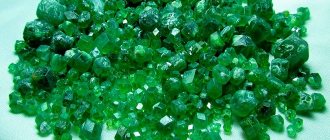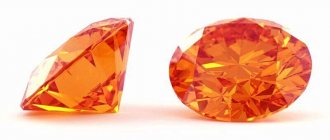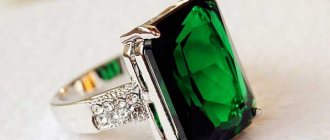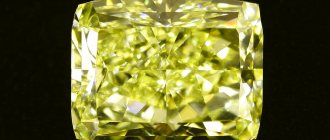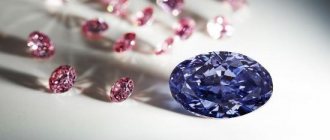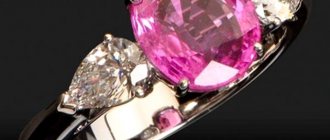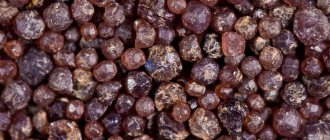Physical and chemical properties
Cognac diamonds are naturally brown diamonds. A colorless diamond is made of pure carbon. Brown specimens are formed due to the fact that, under constant and prolonged exposure to pressure and high temperature, slight deformation of the crystal lattice occurs. During the transformation, atoms of iron, nitrogen and nickel are built into it. Their percentage ratio determines the shade and saturation of the brown color.
| Formula | C |
| Color | All shades of brown, brown-yellow, brown-orange, coffee, chocolate and others |
| Probable impurities | Iron, nickel, nitrogen |
| Shine | Diamond |
| Hardness | 10 |
| Transparency | Transparent |
| Strength | Lasting |
| Kink | Conchoidal to splintery |
| Cleavage | Perfect by (111) |
| Density | 3.47-3.55 g/cm3 |
| singonia | Cubic |
| Refractive index | 2,417-2,419 |
How to improve the shade of a stone manually
The brighter and more natural a stone plays in the light, the more expensive, pleasant and elegant it looks. Often, small inclusions, chips and defects invisible to the eye can be corrected in several ways:
- One of them: cutting off unnecessary parts from the diamond during cutting. It is made by the jeweler himself using special expensive tools. Before this, as a rule, a real jeweler-artist can spend more than one year thinking about which parts of the stone can be cut off.
- The second stage involves skillful grinding and subsequent polishing of the stone. This stage is the final stage in the formation of a masterpiece stone. Sometimes this process can take several weeks, since the slightest wrong movement can ruin both the stone itself and the work done previously.
During these steps, voids may need to be filled to add more value to the stone. This happens as follows:
- a microscopic hole is drilled using a special expensive drill,
- A special material that best matches the color shade is placed into the hole made.
After all the operations performed, only a barely noticeable trace remains from the drilled hole, usually silver in color. Sometimes, under the influence of high temperatures, a dark spot or line may form in the crack, which is removed by the usual action of acid using a purely chemical method.
These works apply not only, for example, to a ring with a cognac diamond, but also to other diamond products.
Cleaning the stone from internal and external defects allows you to improve the quality of the work done, give a brighter and richer shade, which directly proportionally affects the mineral itself and the cost of the future masterpiece.
Varieties of Brown Diamonds
Cognac diamonds are divided into two groups:
- Elite – which includes all fancy diamonds (blue, red and others). Browns in this group are considered the cheapest.
- Cape - yellow-brown gemstones, also called Cognac Diamond.
For convenience, jewelers divided cognac diamonds into the following types based on color:
- Chocolate – dark brown stones of a “delicious” chocolate color.
- Champagne stones are the lightest in their group, pale brown stones.
- Cognac – cognac-brown gems. The most valuable of them have orange tints.
- Walnut - stones the color of a walnut shell.
- Honey or amber are yellowish-orange diamonds.
- Coffee – coffee-with-milk colored stones.
When assessing the quality of a Cognac diamond, the deciding factors are hue (base color), tone (dark or light) and saturation (brightness and depth of color).
Classification
Current breakdown of processed crystals by category:
- elite - fancy, bright, richly colored crystals without nitrogen impurities;
- Cape - yellowish brown, cognac stones, the structure of which contains nitrogen molecules. Due to this impurity, transparency deteriorates and density decreases. This reduces the quality of the stone somewhat.
Classification by color:
- champagne - light, almost yellow specimens with an additional tint;
- brown - most common;
- chocolate - the rarest;
- cognac ones are the most interesting for the public, as well as the most famous (the entire group is named after this color).
In certificates for crystals, color is described by gradation from very light champagne to dark cognac.
Precious crystal
In everyday life, when describing color, they resort to associations - they compare the color of a stone with honey, hazelnuts, gold, bronze, walnuts, coffee beans, cinnamon.
Black and brown diamonds are divided into categories based on their properties and quality, taking into account the richness of their tonality. The more intense the shade, the more expensive the specimen.
Place of Birth
Just a few decades ago, brown diamonds, along with other fancy and colorless diamonds, were mined mainly in Africa.
Now African reserves are practically depleted; colored specimens have not been found for quite some time. The last known deposit is the Argyle mine in Australia, but it is already almost depleted.
Brown diamonds are sometimes found in Brazil, but in very modest quantities.
Features and origin of the stone
The origin of the stone is mainly due to the Australian Argyle mine, which is running dry. Small amounts of this mineral are present in Africa and South America.
The jewelry features of this diamond are such that it harmonizes in a frame made of noble gold, an acceptable tandem with a cognac-colored diamond with rose gold. The yellow noble metal perfectly sets off the stone and gives it a sophisticated look. Platinum and white gold are absolutely not suitable for setting such a stone.
The properties of a cognac-colored diamond are exactly the same as those of colorless or fancy minerals.
The magical properties of cognac diamonds
The properties of diamonds are reflected in their magic - royal splendor, unshakable hardness and strength. They strive to make their owner the same way:
- Strong physically and spiritually.
- Not giving in to difficulties.
- Brilliant and successful in business.
- Purposeful and resourceful.
- Attractive and sexy.
- Confident and ready for any difficulties.
The king among stones makes its owner a “king” among people.
Not everyone can cope with such power and pressure of diamond energy. Therefore, when choosing a stone as a talisman, astrological compatibility should be taken into account.
A cognac diamond will become a faithful friend to a woman who, for some reason, has become disillusioned with herself and has stopped loving herself. The stone will help her raise self-esteem and believe in her own strength.
Gems in Champagne shades bring harmony to life and peace to the soul. Yellow stones attract money, and brown stones attract the attention of others.
Investing in Brown Diamonds
Jewelry is a popular investment destination, and fancy diamonds are one of the most profitable sectors. Research is regularly conducted to determine the prospects of investing in colored diamonds and other jewelry rarities. Based on the results of the latest market analysis, experts assured that cognac diamonds will soon become the most sought-after fancy diamond. Over the first decade of this century, yellow and brown diamonds have already increased in price by 180%, the results of the next decade exceeded 200%.
Auction trading analysts noted that prices for fancy diamonds are now higher than in the past. The most valuable are rare specimens - these include brown ones. The most suitable diamonds for investment are champagne, cognac, chocolate, and walnut-colored diamonds.
Medicinal properties
Cognac diamonds, like all others, carry powerful energy and have a positive effect on the entire human body. Lithotherapists are confident that these gems:
- Slow down aging.
- Restore the psycho-emotional background and treat mental disorders. However, if contact is too long, they can, on the contrary, worsen the situation.
- Reduce temperature, reduce inflammation.
- Removes toxins and neutralizes poisons.
- Reduces stomach and intestinal colic.
- Removes mucus during bronchitis and makes breathing easier.
- Clears skin problems, fights various dermatological problems.
- Helps remove kidney stones.
- Cures diseases of the musculoskeletal system.
Dosed wearing of brown-colored diamonds will be useful for absolutely everyone to improve their overall well-being, strengthen the immune system, and lift their spirits.
How is Cognac color formed?
Some people believe that such an aesthetic shade as Cognac can only be created artificially. This is not true: color is obtained naturally. It is formed due to the centuries-long presence of diamonds underground, where they are exposed to high temperatures and strong pressure.
Because of this, the crystal lattice of the stone is distorted and deformed, and new elements are added to it: iron, nitrogen, nickel, etc. It is due to this that the diamond acquires rich brown shades. Color and tone depend on which microelements in what quantities are added to the diamond.
Products and decorations
Cognac diamonds are framed exclusively in yellow gold; in metal of other shades, brown stones look faded. In very rare cases, rose gold is used.
Today, the cost of Cognac Diamond group gems per carat is around $4,000. In the near future, experts predict a sharp increase - up to $80,000 per carat, which is associated with a shortage of natural raw materials (brown diamonds) and a constant increase in demand for products with them.
This is interesting!
The bulk of cognac diamonds are up to five carats in size. But there are exceptions to the rules - magnificent stones known in the world:
- “Golden Jubilee” - was presented to the King of Thailand on the 50th anniversary of his coronation, after which he was named. Initially it weighed 755 carats, after cutting it began to weigh 545 carats. Today it is valued at $12 million.
- "Darcy Vargas" - named after the first lady of Brazil, weighs 360 carats.
- “Song of Parana” - discovered in 1937 near the Parana River in Brazil, weighs 245 carats.
Some cognac diamonds have left their mark on history, for example, the Aschberg, which belonged to the Romanov dynasty and was later sold to the banker Aschberg. Or they became famous thanks to cinema - “Victoria Transvaal” (68 carats), “Eastern Star” (111 carats), “Kimberly” (70 carats) and celebrities - “Esther Williams” (Hollywood star of the 40s of the 19th century).
Talismans and amulets
Selenite box 7.5 cm
Selenite is magically powerful. It can serve as a talisman, a talisman, and an energy accumulator.
Hindus have always considered selenite stone sacred. Only priests were allowed to wear it. They placed selenite at the head of the bed at night, and in the morning they uttered a prophecy. Rumors about the amazing accuracy of their predictions have survived to this day, perhaps that is why modern soothsayers and people of other magical specialties strive to get a selenite ball into their collection of magical attributes. Even Yogis use the “moon kiss” when conducting telepathic sessions.
For those who do not want to become clairvoyant, selenite will also be useful:
- For women to become more tender, sophisticated and romantic.
- For men, to become braver and accomplish the main feat.
- For married couples, in order to return the spark to the relationship, to make the house not just a place to live, but a cozy family hearth, where mutual understanding reigns, happiness and love reside.
- For businessmen, it’s like an amulet that programs the consciousness for success and helps the subconscious to anticipate dangers, making the owner lucky and attracting financial flows.
- For phlegmatic people, to show greater interest in life, fill it with bright events and impressions, and get rid of excessive slowness and laziness.
- For people of creativity, to reveal themselves to the fullest and never lose inspiration.
- For bachelors and single ladies to meet love and start a family.
- People who have to work a lot with people, talking about something or persuading them - lecturers, teachers, priests, politicians, announcers, lawyers, in order to develop memory and become more eloquent.
How to distinguish an original from a fake
The supply of natural brown diamonds is rapidly decreasing every day, and the demand for them continues to grow. Therefore, jewelers came up with the idea of replacing them with artificially grown analogues - moissanites and cubic zirconia or natural, but forcibly colored colorless analogues. At the same time, they try not to advertise the origin of the inserts in the decoration.
In order not to run into an imitation, first of all, when purchasing, you need to ask the seller for a certificate of quality of the stone, which will indicate its origin.
Very “brazen” fakes (glass and plastic) are quite easy to identify - an ordinary needle will leave a scratch on them.
Skillful imitations can be recognized by the ideality of the structure when viewed at tenfold magnification through a magnifying glass. There are always minor defects inside natural gems - microcracks and air bubbles.
Buying a cognac diamond is an expensive pleasure, so it is better to show the stone to a specialist first. He will test in laboratory conditions the properties of the stone, which cannot be faked:
- reflectivity;
- electrical conductivity;
- the ability to be immersed in a special solution (counterfeits will float on the surface).
In addition, a specialist, based on the presence of certain signs, will determine whether the stone has been refined, whether it has been irradiated, painted, heated, whether cracks have been filled, and so on. The results of all studies will be reflected in the gemological report.
What are champagne diamonds?
Champagne diamonds, also known as dusky, brown or chocolate diamonds, are eye-catching stones that are included in the smorgasbord of brown shades. They occur naturally and range in color from light brown to dark brown.
These diamonds are of natural origin and are known throughout the world: Australia, Africa and Siberia are home to the most exquisite stones of this type. The Australian Argyle diamond mine is considered the largest producer and exporter.
Most mined diamonds have some sort of yellowish or brownish tint that is considered undesirable, so they are sold at a lower price compared to colorless stones.
The most valuable champagne-colored diamonds, however, have a darker hue than typical low-grade yellowish diamonds and are not considered second-rate.
Although champagne-colored diamonds occur naturally, there are stones that are artificially colored using heat treatment under high pressure.
The difference between dark brown and champagne diamonds is determined by the intensity of the color. Champagne color is simply a lighter variety of brown diamonds.
How to care for jewelry
Cognac diamond square
Diamonds are the hardest gems and cannot be scratched by anything other than the same diamonds. But it is still better to store jewelry with them in a separate case or bag, so as not to accidentally damage softer jewelry.
Diamonds are afraid of fat, including the fat on human hands! Therefore, when putting on jewelry and cleaning it, you should try to grasp only the metal, without touching the stone with your fingers.
Otherwise, caring for gems is simple:
- Once a week you need to lightly clean the stone by washing it with a soft cloth soaked in a warm soapy solution (not hot or cold, but warm). After washing, the jewelry should be rinsed with clean water and wiped dry with a velvet cloth.
- Once every six months, cognac diamonds should be shown to a jeweler. He will check the pebble for damage, use an ultrasonic bath to remove germs and dirt from it, strengthen and polish the surface if necessary.
Attention!
High temperatures are harmful to diamonds. Therefore, you should not wash the stones with hot water, dry them with a hairdryer, leave them in direct sunlight for a long time, or wear them in very hot weather.
Various shades of cognac diamond
Cognac is cognac, and the ring with a cognac diamond also has various shades. Each of them is unique and not devoid of admiring brilliance. All this happens, as mentioned above, due to the long-term formation of formations in the earth’s crust under the influence of temperatures.
For example, there are shades called Champagne or Chocolate, as well as other shades, for example: honey, coffee, walnut, gold, hazelnut, cinnamon, bronze.
We did not write the official names of the shades, but wrote the most suitable analogs for them for a more clear visual representation.
Cognac-colored diamonds can take on a variety of shapes, which depend only on the vision of the jeweler-artist.
Determination of purity
The method for determining the purity of champagne color is no different from the methods for determining the purity of other colors. A stone will be considered valuable if it has fewer visible defects both inside and on the surface of the stone.
The advantage of dark-colored diamonds is that all defects are invisible behind this color. But it is worth considering that these stones are no exception and may have:
- Stains are defects found on the surface of a stone.
- Inclusions are defects in the atomic structure that are difficult to repair and mask.
general information
Cubic zirconia was first obtained in 1968. Its name stands for Physical Institute of the Lebedev Academy of Sciences (FIAN). It was in this place that it was first grown, which is why the stone received such an unusual and interesting name. This crystal contains zirconium dioxide.
Creating cubic zirconia is a very complex and time-consuming process. However, its cultivation requires much less cost than the extraction of other precious stones. Therefore, natural crystals are still more expensive. The strength of the gem on the Mohs scale is eight units.
This crystal can be found on sale in different colors, the most common of which are the following:
- green;
- pink;
- yellow;
- brown;
- black;
- blue;
- blue.
Cubic zirconia can also be champagne or lavender in color. To create a certain shade, various impurities are added during the production of the mineral. The decoding here is quite simple. For example, to obtain a green crystal, chromium is added to the raw material, and to produce a pink stone - erbium, red - neodymium, gold - titanium.
Sometimes, during the production of a crystal, several chemical elements are mixed at once, and the result is a stone that has an original color and looks like a gem. It is these types of samples that are most valued by jewelry lovers.
Thus, depending on the color of the mineral, it can pass for various natural materials - garnet, sapphire, emerald, topaz, diamond and even alexandrite. Depending on the country, this gem has other names:
- zirconite;
- jewellite;
- Shelby;
- daimonsquay.
Cubic zirconia is produced using modern equipment, but its cost depends on the production technology. The cheapest stones are colorless and completely transparent. Dyed minerals are already more expensive, and the most valuable stones are those that have many facets and look like a diamond.
Thus, the price of a gem depends on the time of cultivation, its cut and color. A large stone costs approximately three to five dollars.

